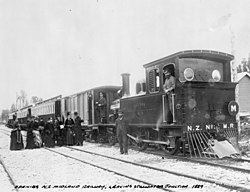Reporting mark NZMRC Track gauge 3 ft 6 in (1,067 mm) | Dates of operation 1885–1894 | |
 | ||
Length 376 km (234 mi) (incomplete) Successor | ||
The New Zealand Midland Railway Company partially constructed the Midland line between Christchurch and Greymouth and the Nelson railway in the South Island. It was one of the few private railway companies in New Zealand, and it did not match the success of the Wellington and Manawatu Railway Company.
Contents
History
In the 1880s, New Zealand's economy was in the grips of the Long depression and the New Zealand Government was in no position to make further investment in railways. The East and West Coast and Nelson Railway Act was passed to enable the railway to be built and operated by private enterprise and a deputation of Sir Arthur Dudley Dobson, Alan Scott and C.Y. Fell visited London to interest financiers in promoting a company.
In July 1885 the deputation accepted an offer from a committee that became the New Zealand Midland Railway Company. The company contracted with the Government in 1886 to build 235 miles (376 km) of railway between Christchurch and Nelson via Brunnerton (later Brunner) within ten years. The fee for this was £2.5m. The company was to get 10 shillings of land for every 20 shillings spent on construction.
However, with insufficient capital and a London management remote from the realities of railway construction in New Zealand it had little chance of success. The company commenced construction from Brunner, the Nelson Section heading up the Grey Valley towards Reefton while the Christchurch line diverged from it at Stillwater. It was not until 1890 that work commenced at the Canterbury end, the contract for the 5.5 miles from Springfield to Pattersons Creek being let to J. & A. Anderson Ltd of Christchurch. The work was to include steel viaducts over the Kowai River and Pattersons Creek.
The company ran out of money and construction ceased on the West Coast in late 1894. On the Springfield section only the Kowai bridges and 4.5 miles to track to Otarama were usable as a railway. The foundations for Pattersons Creek viaduct were in place but the steel superstructure still had to be manufactured and erected.
So in May 1895 the Government seized the company's assets and completed works under the Railways Act 1881, on the grounds that the contract had expired with the works incomplete. Legal argument and court actions between the parties ensued, and was not finally resolved by the Privy Council in England until May 1903. In 1898 the Public Works Department took over and resumed work. The government took over 131 km of track plus 21 stations, 80 bridges, 3 tunnels, 6 locomotives and rolling stock (seven passenger cars and three brake vans). A token payment of £150,000 was made to the company.
Motive power
The company operated mainly 4-4-0 tank locomotives. When it was acquired by the New Zealand Railways Department the first five locomotives, built by Nasmyth Wilson in 1887, were classed La class. The last locomotive was a D class.
